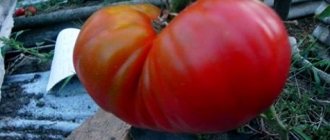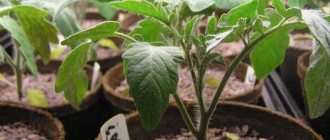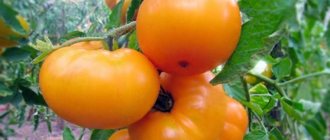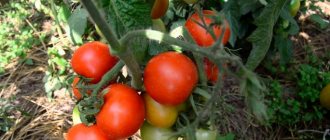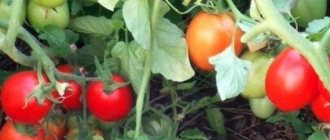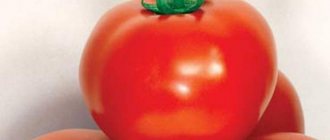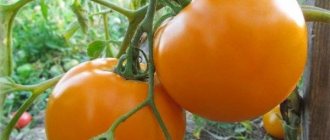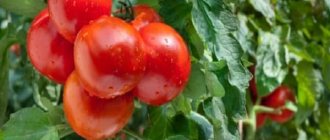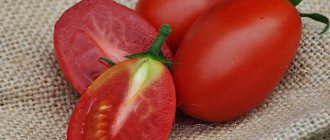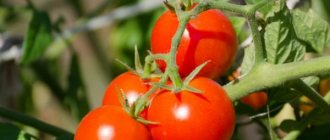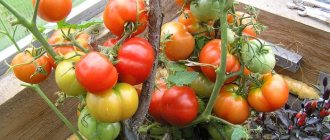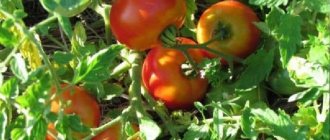The Palace tomato is an excellent large-fruited variety that can withstand temperature changes and produces a harvest even in not the most favorable conditions. What can we say about greenhouses, where it will become the joy of any gardener. Its fruits are tasty and juicy, besides, they ripen early and contain many vitamins.
| Height | Landing location | Ripening time | Fruit color | Fruit size | Origin | Fruit shape |
| Medium height | Greenhouse, Open ground | Early ripening | Reds | Large | Variety | Flat-round |
Agricultural technology
Like most representatives of the culture, it is preferable to grow Antyufey in seedlings. It is advisable to calculate the sowing time yourself, taking into account the climate and growing conditions. For example, in central Russia, the sowing time falls in the second ten days of March. Seedlings necessarily dive in the phase of 2 true leaves. The recommended planting density in protected soil is up to 4 plants per 1 square meter; in open soil you can compact up to 5 bushes in the same area. But the plantings should not be too thick; the plants should be well ventilated so that favorable conditions do not arise for the development of fungal infections. Therefore, if the leaves of bushes growing nearby are in close contact, they should be shortened. The plants are tied to a support; in an ordinary garden bed, our hero can be grown as a stake crop. The most abundant harvest is obtained when the plant is formed into 3 stems. Timely pinching helps increase the productivity of tomatoes. Agricultural technology is common for the crop as a whole. But in a greenhouse you need to control the humidity of the air and soil.
Most Russian tomato growers have yet to become acquainted with this variety. But those few who have already grown the new product speak with confidence about its prospects. The testing showed high productivity of the crop, regardless of growing conditions. Tomatoes have excellent external characteristics, they are resistant to cracking and do not suffer from blossom end rot. The taste is undoubtedly high, but it can let you down if some nuances are not observed. If during the ripening period the plant suffered from waterlogging of the soil and lack of light, then the pulp may turn out to be watery and tasteless. Care is easy, and this is a big plus, since even a beginner can grow Antyufey. No particular shortcomings were identified in the culture. The only negative is that tomato seeds will have to be purchased each time before sowing.
The hybrid is determinate, early ripening. From germination to the beginning of ripening 90-95 days. The first inflorescence is laid above 5-6 leaves, subsequent ones after 1-2 leaves. The fruits are dense, round - elongated, with a “spout”, smooth, red in color without a green spot at the stalk, weighing up to 300 g. The taste is excellent. Characterized by friendly fruiting. The hybrid is resistant to tomato mosaic virus, blossom end and root rot, and Alternaria blight. Heat-resistant, stress-resistant. Resistant to cracking, fruit transportability is good. Planting density 4 plants/m2. Productivity in open ground is 12-14 kg/m2, in protected ground – 16-18 kg/m2.
The best varieties from agricultural companies and collectors for summer residents of the Urals and Russia
Delivery from 170 rub. in Yekaterinburg and another 42,250 points in Russia 24-hour acceptance of orders 450 rub. min. order
Landing Features
To grow this variety in open ground or greenhouses, seedlings are mainly used. Of the planting material of the tomato variety Dvortsovyi Biotekhnika, reviews are predominantly positive. That is why many summer residents prefer Biotechnics to sow seeds.
Growing seedlings and subsequent planting includes a number of rules:
- Before directly sowing the planting material, it is necessary to pour the seeds with a light solution of potassium permanganate and let them stand for half an hour. After this, moisten with a growth activator and let dry;
- To plant seeds, it is necessary to prepare a substrate (a mixture of turf soil, peat and coarse sand). Place it in a small container and sow the seeds;
- It is better to water with a spray bottle, using pre-settled water at room temperature;
- Place containers in a warm, well-lit room;
- After sprouts with the first pair of leaves appear, it is recommended to dive;
- After two or three days, seedlings can be transplanted into peat containers;
- A week before planting in open ground, it is recommended to fertilize the soil with mineral fertilizers;
- When planting, it is worth considering that per 1 sq. m. there should not be more than four bushes with a distance between them of a third of a meter;
- The distance between rows of tomatoes should not be less than half a meter;
- Before planting, it is recommended to fill the bottom of the holes with wood ash;
- After planting, mulch the soil near the bushes with sawdust.
Growing from seeds to seedlings at home
Growing seedlings at home is not as easy as purchasing them, but anything is possible. In addition, this way you will be confident in its quality.
Seed preparation
Seed material must be processed before planting:
- Disinfect with a 1% solution of potassium permanganate. They are placed in this liquid for about 30 minutes to prevent the appearance of viruses.
- Harden the seeds by heating them at a temperature of +55°C for 72 hours. After this, they must be soaked in water at a temperature of +25°C for a day. The final stage is cooling at -2°C (in the refrigerator).
- Treatment with boric acid solution to accelerate growth and increase yield. 2 mg of solution is diluted with a liter of water and the seeds are placed there. After 24 hours, they are taken out and dried until crumbly.
Video: preparing tomato seeds for planting
https://youtube.com/watch?v=PbLZkYCt2iE
Contents and location
Tomato seeds are planted in special boxes with soil. At this moment, the air temperature should not be lower than +16°C. It is recommended to place the boxes on shelves under heating lamps. After 14 days, the small sprouts that appear are transplanted into peat pots.
Did you know? Since 2001, the tomato, as in the Old World before, is considered a fruit by order of the European Union.
Seed planting process
Before planting, not only the seeds, but also the soil need preparation. A mixture is made from turf soil, humus and sand. The material is placed in the soil no deeper than 2 cm. The time for sowing is chosen by the gardener, taking into account the fact that after 50-60 days the seedlings must be transplanted into open ground.
Seedling care
In order for the seeds to shed their shell as quickly as possible, it is necessary to carry out a series of waterings with warm water. Diving is carried out when the plant acquires 2 true leaves (approximately on the 20th day). Watering is done at the root as needed.
Water getting on the leaves can cause the plant to rot. Tomatoes do not like excessive watering. 2 weeks before transplanting seedlings into open ground, they are hardened off, reducing watering. Plants are treated with Bordeaux mixture, fed with potassium and placed in the sun for several hours a day.
For example, for better development of the root system, seedlings are treated with a special solution of water (1 l), ammonium nitrate (1 g), superphosphate (4 g) and sulfate (7 g). The permanent site is also prepared for replanting: within a week it is fertilized with organic matter - 10 kg/sq. m.
Transplanting seedlings into the ground
As a rule, tomato seedlings are placed in open soil in June (mid-month). Each plant is buried in the soil down to the cotyledon leaves - 4-5 cm. The hole is filled with ash or half a teaspoon of Urgas is added.
Immediately after planting, watering and mulching are carried out. The optimal distance between rows is 30-50 cm, between plantings - 30 cm.
Important! For 1 sq. m cannot accommodate more than 4 shoots. Video: planting tomato seedlings in the ground
Video: planting tomato seedlings in the ground
Sowing in greenhouses and open ground
You can grow tomatoes not only with seedlings, but also by sowing seeds directly into open ground. In this case, you need to follow some rules and care features in order to get healthy plants and a large harvest.
Growing conditions
As soon as the soil warms up well, you can begin planting the seeds. It is very important that the threat of frost passes completely. The ideal option in this case is a greenhouse or greenhouse, which allows you to protect the seedlings from pests and sudden temperature changes.
You need to adhere to the following tips:
- first dig up the soil on the site;
- remove weeds and add organic matter;
- prepare the seeds;
- in the greenhouse, maintain a constant temperature within +20...+25 degrees Celsius;
- Ventilate the greenhouse regularly.
The process of planting seeds in the ground
Plant in April, as by this time a stable warm temperature should have established and the soil should have warmed up sufficiently. Planting seeds directly in open ground is carried out according to the following scheme:
- Place the prepared seed material in the holes to a depth of about 3 cm;
- first place fertilizers or ash in the holes;
- 10-12 days after planting, perform the first fertilizing and watering;
- when the sprouts have 2-3 full leaves, row the crops - leave a distance of about 10-12 cm between plants;
- After the plants have 5 full leaves, thread them again, leaving a distance of about 14-16 cm between the bushes.
Watering
Until flowering, water the bushes with warm water every 3-4 days. Follow these tips:
- water directly at the root, in the morning;
- take into account the proportions - 10 liters of water per 1 sq. m area;
- with the beginning of fruiting, increase watering, since by this time the root system is fully formed and the plant directs all its forces to the formation of fruits;
- in case of prolonged drought, increase watering; in case of heavy rainfall, reduce it to a minimum or stop altogether, since excess moisture can cause irreparable harm to plants.
Gentle care
Ground Gribovsky tomatoes require special care. It is necessary to study all the rules that apply to it. After all, tomatoes bear fruit better if they receive more attention.
This tomato variety loves fertile soil and quality watering.
All this is important to ensure their normal development. You need to water the tomatoes once a week, generously and well with warm water, which has stood for several days in a barrel.
It is necessary to feed with mineral and organic fertilizers several times during the growth of tomatoes. To ensure that food arrives faster, the soil is loosened once a week. It is also necessary to mulch the soil. This way the fruits will not lie on the soil.
There is no need to tie or pinch this plant.
But it is important to treat the foliage with special solutions against diseases and harmful insects so that they do not overpower vegetable crops
If tomatoes are grown in a greenhouse, then the greenhouse is always ventilated on a hot day by opening the windows and doors. This controls the humidity level and temperature.
Removing weeds is mandatory, as it takes away all the strength and nutrition from the crops. Tomatoes should not be planted in the same place every year, otherwise they will bear fruit poorly.
The Gribovsky tomato variety will be very popular with those who prefer early salad varieties. It is not difficult to grow it, since caring for a tomato is very simple.
In order for tomatoes to produce a bountiful harvest, it is important to study all the requirements for this care. Happy landing!
Gardeners' opinion about the Palace tomato variety
I have been growing the Palace variety of tomatoes for 3 years. A good variety for the St. Petersburg climate and soil. Thanks to early ripening, it is possible to harvest several times. The fruits grow red, large and juicy. They differ in sweetness. I recommend it to all residents of St. Petersburg!
Ekaterina Agafonova, 45 years old.
On the advice of my work colleagues, I planted the Dvortsovy variety. The experiment was a success. Tomatoes do not require special care. They feel great in greenhouse conditions. I ventilated the greenhouse regularly. The variety is not afraid of drafts. I watered and fertilized, according to recommendations, once every 3-5 days. The fruits grew large and sugary. Next year I will repeat the experience.
Characteristics and features of the variety Mystery of Nature
This variety is recommended for growing in greenhouses. But judging by the reviews of gardeners, it gives good results in open ground. At the same time, it is suitable for all regions of the country, as it is characterized by increased resistance to changes in temperature and humidity, especially in the off-season. But before you give preference to this variety, you should familiarize yourself with its main characteristics.
Description of the bush
The variety Mystery of Nature belongs to the category of indeterminate, so the growth of the main shoot is unlimited. If the basic growing rules are followed, the height of the bush in greenhouses reaches 190 cm, and in open ground - 170 cm. Therefore, the variety needs support and tying up as the shoots grow.
The leaves are medium sized, dark green. The inflorescences are simple. The mystery of nature is a mid-early variety; tomatoes ripen in 108-115 days, which is not bad for a tall variety.
Tomatoes Mysteries of Nature have a flat-round shape and large size. The fruit weight declared by the manufacturer is 250 g, but, judging by reviews from gardeners, the average weight of each tomato is 350-500 g, and individual specimens reach 700 g.
This variety has an unusual two-tone color - pink and yellow. This is sometimes misleading, as it gives the impression of unripe fruit. The main part of the tomatoes is yellow, while the pink color predominates at the stalk.
Note! To obtain maximum yield, tomato bushes must be formed into 1-2 shoots, and the growing stepsons must be removed in a timely manner.
Productivity and taste of fruits
The first flower cluster is formed above the 8-9 leaf, and then every 3. At the same time, the Mystery of Nature is characterized by a high level of ovary, which has a positive effect on yield. Each cluster consists of 5-7 fruits. From 1 plant per season you can get from 7 to 12 kg of tomatoes. Fruit ripening is extended, which allows harvesting before frost.
When cut, tomatoes resemble an exotic fruit. In the center the flesh is a rich pink shade, and closer to the edge it is yellow. Inside each fruit there are 6 seed chambers. The taste of Nature's Mystery tomatoes is sweet with a slight sourness, the flesh is fleshy. The peel is thin, so when consumed it is practically not felt.
Note! Tomatoes of this variety are juicy, so they do not tolerate transportation well and cannot be stored for long periods of time.
Immunity to diseases and pests
The variety Mystery of Nature is relatively resistant to common crop diseases. Therefore, it needs preventive treatment with fungicides
It is also important to observe crop rotation and disinfect the soil before planting.
Pests such as spider mites, whiteflies, and cutworms can also attack tomato bushes. Therefore, at the first signs of damage, insecticides or acaricides should be used.
Advantages of the variety and disadvantages
The main advantages of the variety include:
- Early ripening and large size - like the F1 tomato, the supergiant is pink, grows quickly, produces large fruits;
- Disease resistance;
- Unpretentiousness - recommended for cultivation both in open ground in the south and in greenhouse conditions in the west;
- High yields;
- Excellent taste.
There are practically no disadvantages to tomatoes.
The only negative aspects include:
- The need to tie up bushes;
- Frequent fertilizing.
In percentage terms, the number of disadvantages is significantly inferior to the advantages, which already says a lot.
General description of the Palace tomato and cultivation features
Among lovers of large tomato fruits, the Palace tomato is especially popular. Its fruits have excellent taste. And the plant does not cause any difficulties in caring for it.
The Palace tomato variety feels good in the open ground of the southern regions, and in the northwestern region it is best to use greenhouses and greenhouses.
general characteristics
The Palace tomato variety is considered strong and resistant to many diseases and minor temperature changes. Experienced gardeners take great pleasure in growing tomatoes in their plots.
The fruits have a pleasant sweetish taste with a slight sourness. They have a spicy taste. These tomatoes can be used to prepare a variety of tomato products. These are pasta, juices, sauces, lecho and ketchup.
They are ideal for creating vegetable salads.
But no matter how unpretentious the Dvortsovy variety may be, you need to know its characteristics and main requirements for care and cultivation.
This type of tomato belongs to the determinant series of nightshade crops. An adult bush reaches a height of no more than 1.2 m, and even less in open ground. The plant has a strong and powerful trunk, spreading stems. At the same time, most gardeners recommend installing supports and tying up the bush.
The Dvortsovy variety has its own peculiarity; it necessarily requires the formation of a bush. To obtain large fruits, it is best to leave 1-2 trunks. The foliage of the crop has a normal shape and densely fills the entire plant. Color - rich green.
The inflorescence of the Palace variety is simple. The first formation of the brush begins after 7-8 leaves. The characteristics of the species indicate that its fruits are considered one of the largest. On average, a ripe tomato can weigh from 400 to 600 g. The fruit has a flat-round shape and a bright red color. The peel is smooth and dense. Light ribbing is visible on the surface of the berry.
The harvest can be stored for 3-4 weeks in a well-ventilated and cool area. It tolerates long-distance transportation well.
Growing and care
Tomato variety Dvortsovy is grown using seedlings. Sowing of seeds is carried out a couple of months before planting young shoots in open ground or a greenhouse
When purchasing a package of planting material, you should pay attention to the description and recommendations from the manufacturers regarding the timing of sowing and further care
Before sowing, the seeds must be properly prepared. They are soaked for half an hour in a weak solution of manganese, then in a growth activator. Then let it dry completely.
For seedlings you need to prepare a special soil mixture. To do this, mix turf soil, river sand and peat in equal parts. The soil is placed in a special container and sowing is carried out. Immediately after this, the seedlings can be watered. To do this, it is best to use a spray bottle and settled water.
Store boxes with planting material in a warm room with good lighting. If there is not enough light, fluorescent lamps are installed above the containers.
After about 10-14 days, a pair of green leaves will appear on the sprouts. At this time you can start diving. Seedlings should be planted immediately in peat pots, which will make it easier to plant the plants in a permanent place in the future.
As soon as the threat of frost has passed and the ground has warmed up, you can begin planting seedlings. A week before, the planting material must be fed with complex mineral fertilizer.
Planted on 1 square meter. no more than 3-4 plants. The distance between the bushes should be about 30 cm, and between the rows - at least 50 cm. Each hole in the process of planting the Dvortsovy variety should be filled with wood ash. After the plant is dug in, the holes are mulched using regular sawdust.
Caring for Dvortsovy variety tomatoes is as follows:
- Regular watering is carried out in the early morning with settled water.
- The soil needs constant loosening.
- 10 days after planting, fertilizing is carried out.
The Palace variety tomato has the most positive reviews. It does not cause any difficulties in care. The plant is unpretentious and resistant to many diseases, and its taste is excellent. Every housewife who has at least once planted this tomato in her garden will say that this is one of the best and most versatile fruits among the nightshades.
Care instructions
Like any other garden plant, the Palace tomato needs regular care. Do not forget about the need for periodic weeding and weed removal. Perform tying and feeding. These simple procedures will allow you to get a good harvest of large and tasty tomatoes.
Loosening the soil and weeding
In the fall, be sure to dig up the area where you plan to plant tomatoes. In the spring, loosen twice. Immediately before planting, weed, removing all weeds and roots from the ground. In the future, as the grass grows, weed regularly.
In dry weather, not only water the plants regularly, but also loosen the rows. This procedure will increase the throughput of the soil. On the 45-50th day after planting the seedlings in open ground, hill up and repeat after 2 weeks.
Stepson and garter
Stepping is required to form a bush into one stem - the growing point is pinched and the stepsons on the sides are removed. When the side shoots reach 7 cm in height, carry out the first stepsoning. Then the sprouts can be placed in water and after 20 days a new bush will be obtained. For seedlings, you can use stepsons that were obtained after 1-3 stepsons.
After the bush reaches 30 cm in height, it is recommended to tie it up. To do this, you can use several methods, selecting the one that is most suitable in each specific case:
- Horizontal trellis. Drive stakes into the ground, leaving a distance of about 2 m between them. Then pull the wire or rope, leaving a distance of 30-40 cm between the levels. Tie the bushes in a snake-like manner, carefully hanging large brushes on the hooks.
- Hedge. Using a mesh, a simple structure is created that is stretched between two posts and along the entire planting. At different growth levels, the tomato is tied using twine.
- Wire frame. Externally, the design looks like a rectangular box with a bush inside. There is no need to tie up the plant, because the structure is located around it.
- Stakes. Take wooden stakes, the height of which is about 20-30 cm greater than the bush, and dig it into the soil. You need to install them before you plant seedlings. When the bushes grow, tie them to the stakes using ribbon or cord.
Top dressing
Over the course of one season, it is necessary to fertilize several times, adhering to the following scheme:
- in the fall, apply organic (10 kg per 1 sq. m), phosphorus (20 g per 1 sq. m) and potassium types of fertilizers (20 g per 1 sq. m);
- in spring use a nitrogen mixture - per 1 sq. m 10 g of product;
- on the 10th day after planting, use a liquid type of fertilizing - nitrogen (25 g), phosphorus (40 g) and potassium fertilizer (15 g), dissolved in 10 liters of plain water (this volume of solution should be enough for 14 bushes);
- after 7 days, perform another feeding using the previous product, but now distribute the specified volume over 7 bushes;
- in the aisles, place a dry type of fertilizer - nitrogen (5 g per 1 sq. m), phosphorus (10 g per 1 sq. m), potassium fertilizer (10 g per 1 sq. m);
- You can also use liquid organic matter for fertilizing.
general characteristics
The Palace tomato variety is considered strong and resistant to many diseases and minor temperature changes. Experienced gardeners take great pleasure in growing tomatoes in their plots. The fruits have a pleasant sweetish taste with a slight sourness. They have a spicy taste. These tomatoes can be used to prepare a variety of tomato products. These are pasta, juices, sauces, lecho and ketchup. They are ideal for creating vegetable salads.
But no matter how unpretentious the Dvortsovy variety may be, you need to know its characteristics and main requirements for care and cultivation.
This type of tomato belongs to the determinant series of nightshade crops. An adult bush reaches a height of no more than 1.2 m, and even less in open ground. The plant has a strong and powerful trunk, spreading stems. At the same time, most gardeners recommend installing supports and tying up the bush.
The Dvortsovy variety has its own peculiarity; it necessarily requires the formation of a bush. To obtain large fruits, it is best to leave 1-2 trunks. The foliage of the crop has a normal shape and densely fills the entire plant. Color - rich green.
The inflorescence of the Palace variety is simple. The first formation of the brush begins after 7-8 leaves. The characteristics of the species indicate that its fruits are considered one of the largest. On average, a ripe tomato can weigh from 400 to 600 g. The fruit has a flat-round shape and a bright red color. The peel is smooth and dense. Light ribbing is visible on the surface of the berry.
There are few seeds in tomatoes. The pulp is dense and juicy. The Dvortsovy variety is not prone to cracking. Anyone who has planted these tomatoes knows that their yield is good and directly depends on watering and regular feeding. It is this fact that plays an important role in obtaining a rich harvest. Under all favorable growing conditions, up to 7-8 kg of tomatoes can be harvested from one bush per season.
The harvest can be stored for 3-4 weeks in a well-ventilated and cool area. It tolerates long-distance transportation well.
All about the Palace tomato variety
The berry feels great in open ground in the south of the country. In the North-West region, tomatoes require greenhouse conditions. General characteristics of the variety:
- the height of the tops reaches 120 cm;
- simple inflorescence;
- precocious;
- low-seeded;
- resistant to many tomato diseases;
- The first inflorescence is tied on the 7-8 leaf.
The fruits of this variety are considered one of the largest and are distinguished by:
- large fruits, with a maximum weight of up to 600 grams;
- flat-round shape of the fruit;
- ribbed;
- The color of the ripe fruit is bright red;
- sweet, sugary taste.
IMPORTANT! A distinctive feature of the variety is the need for regular fertilizing and watering of the soil!
Productivity, characteristics and description of the Blueberry tomato variety
The Blueberry tomato is an innovative tomato variety with a unique blueberry fruit color. Tomatoes of this variety differ from their relatives in their rich dark blue-black color.
The fruits acquired such an unusual color due to the presence of special purple pigments in their composition. But it’s not just the color scheme that distinguishes these varieties from their red relatives. Such tomatoes contain the substance anthocyanin; it is anthocyanins that give the fruits a very unusual color. These substances are found in large quantities in fruits such as blueberries, eggplants, and black currants.
Anthocyanins get into tomatoes in two ways:
- Using genetic engineering.
- With the help of selection, the method of natural selection.
Our variety of Blueberry tomatoes, fortunately, has nothing to do with genetically modified products. We owe the development of this variety to breeders from the USA and, in particular, to Jim Myers from the University of Oregon, who used the Indigo Rose tomato variety as the basis for this variety. The result is a variety very similar to Indigo Rose, but with larger fruits.
Useful properties of this variety
Blueberry tomato has a whole range of useful substances, these are:
- A huge amount of antioxidants that cleanse the body from the inside.
- Anthocyanins strengthen the human immune system, strengthen the walls of blood vessels, and are an excellent prevention of cardiovascular diseases.
- Vitamin A in the fruit perfectly strengthens vision.
- Lycopene is an excellent prevention of malignant neoplasms.
The advantage of this variety is also its ease of care and resistance to various types of pests and diseases.
Characteristics of this varietal variety
This blueberry tomato belongs to the early ripening varieties. This is an indeterminate variety.
The bushes are quite tall and require staking and pinching. The foliage is medium, the leaves are rich green. Simple and long brushes are formed on the branches, which seem to droop downwards. 6-8 fruits are formed on the hands. At the initial stage of ripening, the fruits are green and no different from ordinary red tomato varieties. But, in the process of ripening, the fruits acquire a dark burgundy color with a bright blue tint. The fruits have a regular round shape and weigh 140-180 grams.
The stated description of this variety indicates the high resistance of tomatoes to various diseases and pests.
This tomato is suitable for fresh consumption, as well as for processing. It is used in the kitchen like regular varieties of tomatoes, in the preparation of various dishes, juices, ketchups, and sauces. Fruits are excellent for canning.
How to grow
This variety is grown according to the standard scheme. The variety is excellent for growing in open ground, as well as in a greenhouse.
At the initial stage, the seeds are sown for seedlings. When the first true leaf appears, they are picked into separate containers. And after several true leaves appear, you can safely plant the seedlings in open soil.
Important to remember! Tomatoes are planted in open soil after the spring frosts have subsided. To get the harvest earlier, you can plant tomatoes in a greenhouse.
To get the harvest earlier, you can plant tomatoes in a greenhouse.
The Blueberry tomato variety will delight you and your loved ones not only with its very unusual color, but also with its excellent taste.
After eating the seedlings
- Sow 60-65 days before transplanting into a greenhouse or beds.
- It is advisable to prepare the seeds for sowing - soak them for 2-3 hours in biostimulants - Epin, Zircon, Ecosil. You can use aloe juice. To do this, a leaf of aloe vera is cut from the plant a week before the procedure. And all this time they keep it in the refrigerator so that the biologically active substances are maximally activated. Then the juice is squeezed out of the leaf, 1 teaspoon of it is diluted in 0.5 liters of water. Drain a little liquid from the jar and soak the seed in it.
- Along with the usual store-bought ones, perlite, vermiculite, and agroperlite can also be excellent soils for germinating seeds. They retain moisture well, have poor nutritional value, and do not require the addition of fertilizers (seeds do not need them at all for successful germination and can even harm them). The consistency resembles loose fine sand, so it is very convenient to extract sprouts with roots from such soils: even the smallest sprouts of the roots are not injured.
- The know-how of gardeners over the past few seasons has been germinating seeds in... worn out tea bags. Those who have used this technique say that the seeds germinate faster and supposedly receive an excellent “charge” for further growth in tea leaves, due to which they develop faster, stronger and healthier, unlike seedlings grown in other conditions. You can try an experiment!
- Shoots appear at a temperature of about + 20 degrees. Therefore, it is advisable to keep the bowls with crops until germination, for example, on a battery.
- With the appearance of the first true leaves, the seedlings should be planted into separate containers so that the emerging bush has enough nutrition.
- It is important to place containers with seedlings on the lightest windowsill, ideally with a southern, southeastern or southwestern orientation. If the sun shines very brightly at noon, the seedlings should be shaded. A great option for this is roller blinds on the windows. If they are not there, you can shield the young plants with a sheet of paper leaning against the window glass.
- On the contrary, seedlings should be grown in nutritious soil. You can use regular store-bought compost (Rassadny) or mix compost, garden soil and coarse sand (2:2:1).
- The scourge of seedlings is the so-called “black leg”. It spreads like lightning. It happens that, for no apparent reason, almost all the seedlings die in a bowl in a day. It begins with the fact that in the first cases the stem becomes thinner and darker near the ground: the young plant seems to give way and fall to the ground. To prevent this fungal disease, “Fitosporin” is used; it is added to the soil during its pre-sowing preparation.
- Caring for seedlings is simple: timely watering, loosening the soil (so that air can flow to the roots faster), combined with watering and fertilizing with complex mineral fertilizers once a week. It is better to reduce the dose of fertilizer recommended in the instructions by 2 times.
- It is important to avoid drafts! Because of them, tomato seedlings can not only get sick, begin to lag behind in development, but also die.
- Growing plants are drawn towards the sun's heat and light, which is why the still fragile stems can bend. Therefore, containers with seedlings should be periodically turned over to the opposite side in relation to the window glass.
- Before planting in open ground, it is advisable to harden the seedlings - gradually begin to accustom them to open air and lower night temperatures. You can take it out onto the veranda for several hours at first, gradually increasing this time. Then leave it there overnight, and later put it out to spend the night in the yard. Hardening usually takes a couple of weeks. This procedure will help tomato bushes quickly adapt to new conditions, relieve inhibition in development and help the plants survive the stress of replanting faster and with minimal losses.
How to plant and grow palace tomato
- The shape is round, smooth, even.
- Color red or pink.
- Weight 50-80 g.
- Inside there are 2-4 seed chambers with a small number of medium-sized seeds.
- The taste is excellent, tomato.
- The pulp is juicy, dense, sweetish with a slight sourness.
- The fruits have a beautiful presentation.
- The concentration of dry substances is about 6%.
- The skin is dense.
- Do not crack.
- Resistance to transportation.
- Can persist for a long time.
Among the advantages of this variety are the following:
- Unpretentiousness to growing conditions.
- Great taste.
- Precocity.
- High immunity to most nightshade diseases.
- Suitability for transportation and long-term storage.
Flaws:
- Susceptibility to some nightshade diseases.
- It is not economically effective when grown in protected soil.
The Dvortsovy variety is resistant to diseases and slight fluctuations in air temperature, which is noted by many gardeners. The fruits are known for their pleasant taste with a slight sourness and are perfect for salads, sauces and ketchups.
The Palace tomato variety is distinguished by its unpretentiousness, high productivity and sustainability. Recommended both for planting in open ground and for greenhouse cultivation. The article will tell you about the features of this variety and the rules of cultivation.
Reviews
When mentioning the palace tomato variety, reviews from summer residents and gardeners are in most cases positive.
Considering the number of advantages of this plant over other representatives of tomatoes, it is not at all surprising that many gardeners have firmly decided to plant this particular variety next season.
Excellent taste, early ripening and high yields of tomato are decisive factors noted by many summer residents.
The Dvortsovy variety compares favorably with other tomatoes in terms of early ripening, yield and resistance to diseases. These features determined the predominance of positive reviews on the network.
You can see how the Dvortsovy variety of tomatoes are harvested by watching the video:
